Houdini Isn't Scary
rom here, I'll take you through Houdini the way I learnt it but with far less of the hiccups that I had going through it. We'll start with the basics in this part and gradually build up to advanced dynamics as the weeks go by. Feel free to leave any questions you have in the comments below and we will get back to them. Houdini is an incredible piece of software and I believe everyone who is interested in 3D, VFX and/or CGI should take the time to learn it. Hopefully through this tutorial series, I can help you learn Houdini in an intuitive way.
9 チュートリアル 0:18:27
チュートリアル

Houdini Isn't Scary | Part 1 | Basics
A tutorial series which goes over the absolute basics to allow people to find the path of least resistance into Houdini. It is important to me that people are not intimidated by Houdini as it is an incredible piece of software with some of the most amazing support I have ever had the pleasure of dealing with. This series attempts to allow people into Houdini as complete beginners with only a very basic level of understanding of 3D principles.

Houdini Isn't Scary | Part 2 | Objects
Welcome back to Part 2 of Houdini Isn't Scary. In this part, we pick up from where we left off last time. We are going over objects. In Houdini, we place objects in our object network. Each object contains further nodes. As such, each object is a culmination of many nodes. We represent the chain of nodes as one object. This tutorial shows how we can work with multiple objects and have them relate to each other. Furthermore, we also touch on attributes. These are one of the biggest upsides to Houdini. In the next part, we are starting on dynamics. Hope you enjoy!
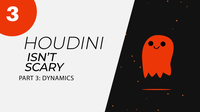
Houdini Isn't Scary | Part 3 | Dynamics
In this part, we go over how to create dynamics. Dynamics are things that are driven by time. In Houdini, there is a separate context for working with Dynamics; it's called DOPs (Dynamic Operators). Other geometry based work is done in SOPs (Surface Operators). In this tutorial though, we are going to be working with POPs (Particle Operators which are a subset of DOPs).
When we create a dynamics network, we intend on outputting a simulation. A simulation is simply the calculated output of a dynamics network. If our network tries to calculate how liquid would move over time, it would take fluid dynamics into account, do some calculations (this part takes time for the computer to do) and then output a simulation. If we change anything in the dynamics network, we would need to re-simulate. All of the calculations are done by what is known as a solver. Each type of dynamics network in Houdini uses a different solver (FLIP, Pyro, Vellum, RBD, etc.).
The idea in this part is to create some particles, sprinkle them over the donut dynamically, bring it into our sprinkles node, and turn each particle into a sprinkle with our existing setup.
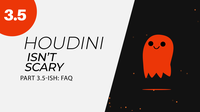
Houdini Isn't Scary | Part 3.5 | FAQ
Welcome back to another Houdini Isn't Scary Tutorial. This one is more of a clarification lesson. I highly suggest you watch it as it goes over some important techniques for not losing your mind and crying into a pillow while using Houdini. These are some of the 'Gotchas' in the basics of Houdini and this tutorial will remove the fear factor from each problem you may have.
In Part 4, we will be tackling a brand new section of Houdini so you can treat this as a breather for now.
If you need anything or have any questions, please leave a comment down below. Even if you have a criticism or suggestion, we're always happy to hear from you. If you found some value in this video, please consider leaving a like, subscribing and/or visiting our Patreon.
Thanks for watching!
Patreon:
https://www.patreon.com/NineBetween
0:18:27
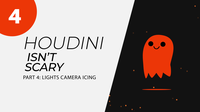
Houdini Isn't Scary | Part 4 | Rendering Setup
Welcome back to Houdini Isn't Scary - Part 4: Lights, Camera, Icing. In this tutorial, we are going over the setting up of a render. 'Rendering' is the process of taking our objects and creating an output. That output in this case is an image.
When we render in Houdini, we are basically taking a picture of the objects in our scene (the donut, icing and sprinkles). Much like in real life, you cannot take a picture unless you have a camera and your camera is useless unless there is light. In Houdini we create lights and a camera. However, something else that comes into play is the way that the actual objects interact with light. Objects are gold, pink, black, white, rough, glossy, metallic, see-through etc... We need to do this in Houdini as well. For this, we create materials.
These materials control the way our objects look. We control all of the needed settings for our materials by using a shader. A shader is a system that controls how light shades an object. In Houdini, we generally use the Principled Shader. This is a shader that is meant to be intuitive and simple because it has been cut down to its basics. However, it strives to be realistic in the way it represents objects. Simply, we don't have to do any complicated math as to how light bounces or interacts with an object, we can just set some parameters and the Principled Shader does the rest. It also comes with presets. You want glass? Use the glass preset. You want gold paint? Use the gold paint preset. You want anything else? You can make it yourself with little difficulty.
Finally, once we have all of that, we can render our scene. In the next part, we will see how to save the renders to disk. We will also cover what are known as ROPS. They have their own extra settings that we can configure which change the way the render comes out.
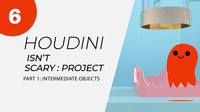
Houdini Isn't Scary Project | Part 1 | Intermediate Objects
This tutorial goes over how to begin creating a simple effect based on current popular 3D renderings.
This part is the start of the Project part of this series. We are going to be creating a reasonably simple effect where we drop a ball through a pipe onto a platform. The ball then bounces twice, after which, it turns into a fluid. In this part, we're setting up all of the necessary objects for this video.
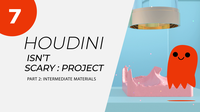
Houdini Isn't Scary Project | Part 2 | Intermediate Materials and Lighting
Part 2 of the Houdini Isn't Scary Project. In this part, we go over materials and lighting for the scene created in the previous part. It is part of a project to ease non-Houdini users into Houdini and broaden the audience that Houdini is viable for. This one explains how HDRIs work in conjunction with Mantra, why it is better to use fewer light sources, how to decrease shadow intensity and many other aspects of the lighting process in Houdini.
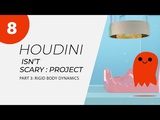
Houdini Isn't Scary Project | Part 3 | Rigid Body Dynamics
This is part 3 of the Houdini Isnt Scary Project where we start on the dynamics of the project. This part goes over basic Rigid Body Dynamics and how to set up the dynamics network. We cover the setup and how to set the initial state of your simulation. It covers the physical properties of dynamics objects. Additionally, it covers outputting the dynamics using a DOP I/O.
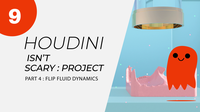
Houdini isn't Scary Project | Part 4 | FLIP Fluid Dynamics
The more difficult part of the dynamics of this project. It introduces new users to Flip dynamics and how to set up a simulation without shelf tools so that there can be a development of independence and understanding. It covers the basics but also touches on some more intermediate areas of the flip solver and related network aspects.